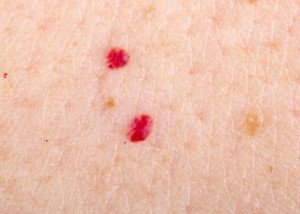Very tiny, bright red dots popping up over time on the breast can make a woman think this is a sign of breast cancer.
Breast cancer awareness is very important and has ongoing and strong publicity.
More and more women – including younger – are becoming increasingly conscious of this disease and its signs, plus any new changes in their breasts.
So when a woman notices a tiny bright red dot on her breast – and especially if she notices more bright red little spots appearing over the course of time – this can get her heart racing.
“It is important to have a routine skin cancer screening in addition to mammograms annually to verify the cause of these lesions,” says Erum Ilyas, MD, a board certified dermatologist who performs adult and pediatric medical dermatology, cosmetic dermatology and skin cancer treatment with Schweiger Dermatology Group.
Dr. Ilyas continues, “However, the most common reason I see patients for ‘bright red dots’ actually turn out to be angiomas, also referred to as cherry angiomas. These benign lesions are not related to skin or breast cancer.”

Angiomas. Shutterstock/Ocskay Bence
Angiomas, which do not need to be removed other than for cosmetic reasons, tend to come after age 30 and especially after 40.
They may be flat or slightly elevated. They are also known as strawberry angiomas.
If one of your parents has a bunch of these tiny red spots, chances are, you will begin noticing them on your own body by the time you reach 40.
They can appear pretty much anywhere where there is skin, including the skin of your breasts.
But here’s what you need to know: An angioma (also known as a hemangioma) is a dermatological situation, not a gynecological one.
What exactly is an angioma?
They are very superficial – and benign – dense masses of very tiny blood vessels, which is why most are “bright” red.
They may also appear orange-red and reddish-magenta.
Since this is an issue of the skin, there is no reason why angiomas wouldn’t also appear on the skin that covers a woman’s breasts any less than they would appear on one’s trunk, back, shoulder, neck or arms.
Angiomas, regardless of their location, have no connection to cancer of the breast, skin or any other organ.
As for actual signs of possible breast cancer other than a lump that you can feel, these include puckering of the skin on a breast, an inverted nipple when it’s never been inverted before, a relentlessly itchy nipple, and unusual discharge from a nipple.
If you experience any of these signs, you should make an appointment immediately with your gynecologist.
 Dr. Ilyas has practiced dermatology in the Philadelphia area and Boston for 15+ years and has served as Assistant Professor of Dermatology at Drexel University College of Medicine.
Dr. Ilyas has practiced dermatology in the Philadelphia area and Boston for 15+ years and has served as Assistant Professor of Dermatology at Drexel University College of Medicine.
 Lorra Garrick has been covering medical, fitness and cybersecurity topics for many years, having written thousands of articles for print magazines and websites, including as a ghostwriter. She is also a former ACE-certified personal trainer.
Lorra Garrick has been covering medical, fitness and cybersecurity topics for many years, having written thousands of articles for print magazines and websites, including as a ghostwriter. She is also a former ACE-certified personal trainer.
.









































